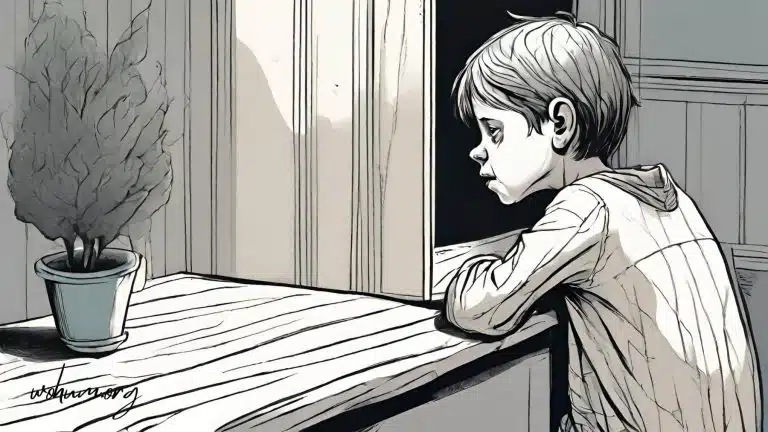Navigating the world of childhood development is like embarking on a journey with unpredictable twists and turns. As parents, understanding the intricacies of our children’s emotional landscape is crucial. One aspect that often leaves parents puzzled is social anxiety in 8-10-year-olds. In this guide, we’ll unravel social anxiety’s mysteries and equip you with the tools to recognize and support your child.
Understanding Social Anxiety in Children
Picture this: your child hesitates before approaching a group of classmates or avoids eye contact during conversations. These behaviors might be more than just shyness; they could be signs of social anxiety. Social anxiety in children is more common than we might think, and understanding its roots is the first step in providing the proper support.
Read our related article Understanding Anxiety in Children
Importance of Early Recognition
Why is early recognition crucial? Imagine discovering a map to decode your child’s emotions and behaviors. Early recognition empowers parents to intervene effectively, preventing potential long-term impacts on a child’s social and emotional well-being. Let’s explore the signs and symptoms that might be red flags together.
Signs and Symptoms of Social Anxiety
Behavioral Indicators
- Avoidance of Social Situations
Social events that seem like a breeze to other children become daunting for those grappling with social anxiety. Your child might be reluctant to join group activities or shy away from playdates. - Difficulty Making Eye Contact
Eye contact is a gateway to connection. A child with social anxiety may struggle maintaining eye contact, signaling discomfort in social interactions. - Excessive Worry About Peer Judgment
“What if they don’t like me?” This thought might be a constant companion for a child with social anxiety. Excessive worry about peer judgment can hinder a child’s ability to engage with others.
Physical Manifestations
- Stomachaches and Headaches
Unexplained stomachaches or headaches before social events might be your child’s way of expressing the internal turmoil associated with social anxiety. - Sleep Disturbances
Social anxiety can cast its shadow into the night, causing sleep disturbances. If your child has trouble sleeping before social events, exploring the root cause is worth exploring. - Changes in Appetite
Notice sudden changes in your child’s eating habits? Social anxiety can sometimes manifest as appetite fluctuations, reflecting emotional distress.
Understanding these behavioral and physical signs is pivotal, but uncovering the causes behind social anxiety is equally important. Join us in the next section as we delve into the biological factors and environmental influences contributing to social anxiety in children.
What Causes Social Anxiety in Childhood?
Is social anxiety nature or nurture?
The origins of social anxiety involve both nature and nurture. Biological factors (nature) can predispose individuals to anxiety. Still, environmental influences (nurture), such as family dynamics and early social experiences, also significantly shape how social anxiety manifests. It’s a complex interplay between genetics and environment.
Biological Factors
In a child’s brain, essential messengers called neurotransmitters, like serotonin and dopamine, play a vital role in shaping emotions. If these messengers get disturbed, it can lead to feelings of anxiety and sadness.
Environmental Influences
- Family Dynamics
The family unit serves as the initial social sphere for a child. Family dynamics can significantly impact a child’s perception of social interactions. Understanding these dynamics is critical to fostering a supportive environment. - School Environment
The school environment is a melting pot of social interactions. Examining how school dynamics contribute to social anxiety helps us create strategies to navigate this crucial aspect of a child’s life.
Age-Specific Considerations
Why Social Anxiety Peaks in 8-10-Year-Olds
Navigating the landscape of childhood, particularly between the ages of 8 and 10, presents unique challenges. Children actively develop their social identity during this period, and the pressure to fit in intensifies. Understanding the reasons behind the peak of social anxiety in this age group is crucial for providing targeted support.
Normal Social Development vs. Red Flags
Distinguishing between normal social development and potential red flags can be challenging. We’ll unravel the subtleties of age-appropriate behavior, ensuring you can identify when your child’s social experiences might warrant closer attention.
How to talk to a child with social anxiety?
Initiating a conversation about social anxiety requires a delicate approach. This section will explore strategies to create an open environment where your child feels comfortable expressing their thoughts and emotions.
Creating an Open Environment
- Building Trust Through Listening
Cultivate trust by actively listening to your child’s concerns. Providing a non-judgmental space encourages them to share their feelings without fear of criticism. - Expressing Empathy
Empathize with your child’s experiences. Acknowledge their emotions and reassure them that their feelings are valid. This validation forms the foundation for open communication.
Encouraging Honest Communication
- Using Age-Appropriate Language
Tailor your language to your child’s developmental stage. Use simple and relatable terms to ensure they understand, making them more likely to express themselves. - Sharing Your Own Experiences
Share relatable stories from your childhood, highlighting that everyone faces challenges in social situations. This helps your child see that social anxiety is a common growing-up aspect.
Also, Explore Types of Language in Early Childhood: Parent’s Communication Guide
Building Social Skills in Children with Social Anxiety
Equipping your child with practical social skills is a proactive approach to managing social anxiety. This section will explore the role of playdates and extracurricular activities in fostering social development.
A. Playdates and Social Opportunities
- Choosing Supportive Playmates
Facilitate playdates with understanding and supportive peers. Positive social interactions during play can boost your child’s confidence and ease social anxiety. - Guided Social Activities
Engage in guided social activities that promote teamwork and communication. Board games, art projects, or team sports provide structured settings for developing social skills.
Role of Extracurricular Activities
- Exploring Diverse Interests
Encourage your child to explore various extracurricular activities. These activities, from sports to arts, nurture their passions and provide opportunities to build connections with like-minded peers. - Team Building and Collaboration
Activities that emphasize teamwork and collaboration foster a sense of belonging. This can be particularly beneficial for children with social anxiety, helping them build positive associations with group interactions.
Seeking Professional Help
Knowing when to seek professional assistance is crucial to supporting a child with social anxiety. This section offers guidance on consulting pediatricians and involving school counselors.
When to Consult a Pediatrician
- Persistent and Intensifying Symptoms
Consulting a pediatrician is advisable if your child’s social anxiety symptoms persist or intensify over time. Professional evaluation can provide insights into potential underlying issues. - Impact on Daily Functioning
Consider professional help if social anxiety interferes with your child’s daily functioning, affecting their academic performance, friendships, or overall well-being.
Involving School Counselors
- Collaborating with School Staff
Initiate a collaborative effort with your child’s school. School counselors can play a vital role in understanding and addressing social anxiety within the educational context. - Individualized Education Plans (IEPs)
Work with school counselors to develop individualized plans that accommodate your child’s social needs if needed. IEPs can offer tailored support, ensuring a conducive learning environment.
Conclusion – Social Anxiety Disorder
Recap of Key Takeaways
Navigating childhood development is a journey with twists. Understanding social anxiety in 8-10-year-olds is vital. This guide unravels its mysteries, empowering parents with tools to recognize and support their children. Recognizing signs early is key to effective intervention, preventing long-term impacts. From behavioral indicators to biological and environmental influences, we explore the complexity of social anxiety.
Understanding its nature, nurturing a supportive environment, and recognizing age-specific challenges is crucial. Initiating conversations with a child about social anxiety requires a delicate approach, building trust through listening, expressing empathy, and encouraging honest communication. Practical tips for building social skills, such as supportive playdates and extracurricular activities, are explored. Knowing when to seek professional help and collaborating with pediatricians and school counselors is highlighted.
How To Deal with Social Anxiety in a Child?
To deal with social anxiety in a child:
- Recognize the Signs: Identify behavioral and physical indicators of social anxiety, such as avoidance of social situations or physical symptoms like stomachaches.
- Open Communication: Create a relaxed environment for your child to express their feelings. Encourage honest communication about their experiences and fears.
- Build Social Skills: Foster social development through guided playdates and extracurricular activities. Positive social interactions can boost confidence.
- Seek Professional Help: Consult a pediatrician if symptoms persist or intensify. Collaborate with school counselors to address social anxiety in an educational context.
- Provide Parental Support: Be a source of understanding and encouragement. Your support plays a crucial role in helping your child navigate social challenges.
As you embark on this journey, know that you are not alone. The challenges of parenting are shared by many, and the collective strength of our community is a source of inspiration and encouragement. Together, we can foster a generation of emotionally resilient, socially confident individuals.


